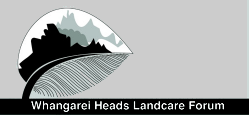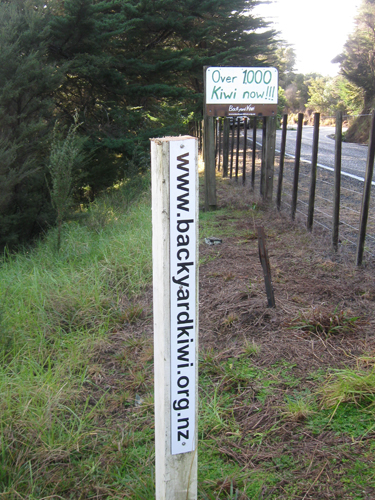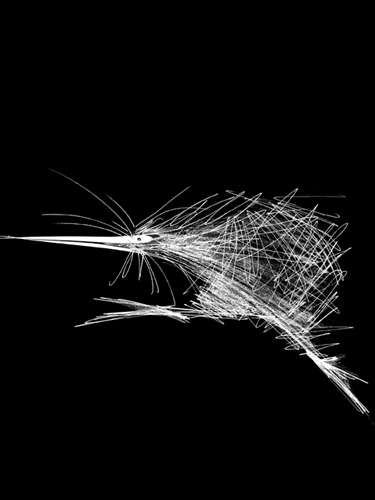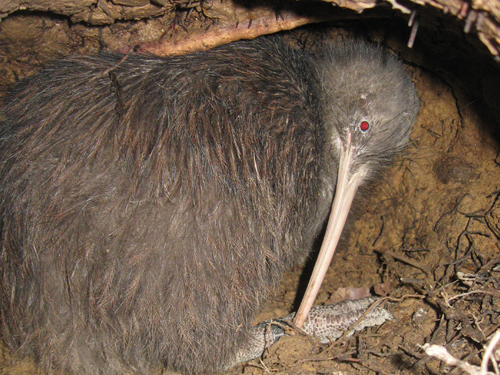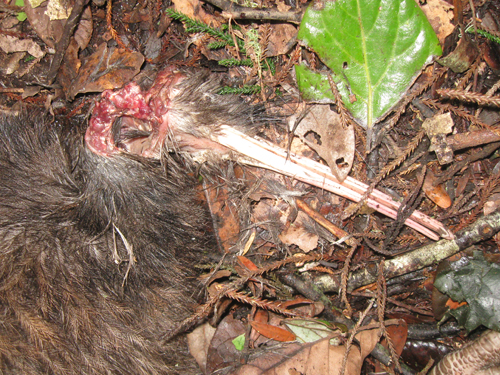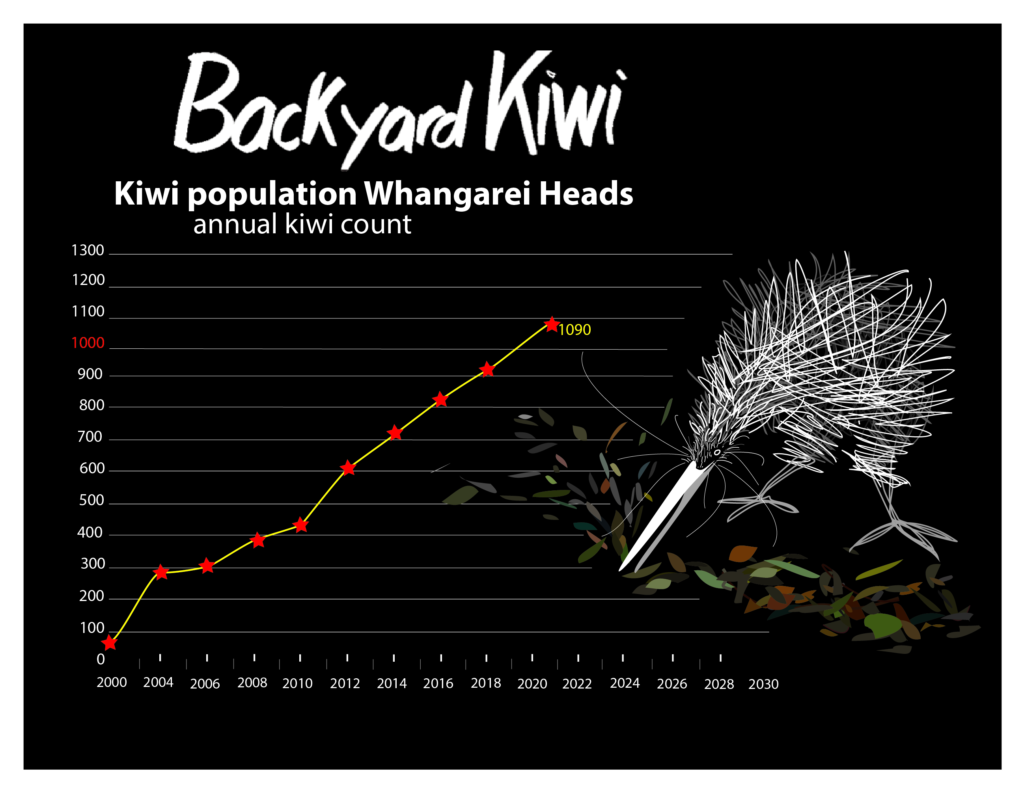2021 July Report
Plenty happened in July
Apologies for the lateness of this update.
- Thanks to Kiwis for Kiwi and DoC for running the annual Kiwi Hui at Tūteao and Uiraroa marae in Te Teko, Bay of Plenty recently. Great hosts! Thanks to DoC Whangarei and NRC for running a good Northland contingent down. Great to catch up with other kiwi folk from around the country and hear about what has been happening.
- Final kiwi count data processed – 1090 adult kiwi was the overall count for the Heads! A great result.
- Fay and I had a group of Parua Bay Enviro students out kiwi listening one evening – after the peak calling period but they still enjoyed hearing a pair call from the paddock below the Manaia Club. Thanks to Sam Ogle and Shirley for organising this.
- Another road killed kiwi in the usual hot spot between McLeod Bay and the Nook. He was 1100g and 75mm bill – so a young one that had grown to be just big enough to fight off a stoat.
- Stolen BYK road sign. Some ratbag has souveniered the sign opposite the Parua Bay Cemetery .
Backyard Kiwi Predator Control Program:
Catches for July : 2 stoats, 4 weasels, 2 cats, 124 rats, 8 hedgehogs, 8 possums.
What your kiwi have been up to:
The adult males are settling down for the long nesting stint ahead and the females are taking a well-earned break feeding up after laying 2 huge eggs.
Whangarei Heads radio tracked Kiwi.
- Wally – Is nesting hard in a pampas bush in a patch of gorse at the end of Campbell Road. He was 34 days in on 23/7/21and at a good low nightly activity of 3 hours.
- Ross – In the valley at the top of Pepi Road. This guy isn’t showing nesting signs and is still very active at 12 hours nightly activity.
- Teina – In his usual area in the northern area of Martins’ Owhiwa Road forestry block. Nightly average activity of 11 hours.
- Malaika – Still hanging in the valley of native bush just west of Owhiwa Road on Martins’ block. Her activity is now back up to a steady. 11 hours. She is still quite close to Chookie so they may have paired up.
- Beach Girl – She is settled between Ross Road and Owhiwa Road and is busy with 11.5 hours nightly activity.
- Pakipaki – Still in the pampas filled drain in the Johnsons’ paddock McLeod Bay. 10 hours activity.
- Chookie – as suspected his first nesting attempt failed after 20 days but he has got straight back into having another go. Nesting 11 days on 6/8/21 and 6 hours activity. In pampas in Martins’ pines Owhiwa Road.
- Valentine – She has spent another month in and around the Plants’ block off Taruanui Road. 12 hours nightly activity.
Rarewarewa/Purua- O.N.E. Dads
Most getting on to nesting. But Cliff was found dead – possible ferret kill (see pic and one of him in better days). BIG Thanks to Julz of DoC who has reacted quickly and set some live capture traps in the area and caught a ferret 50m from where Cliff was killed. Both Cliff and the ferret are being DNA tested to see if he is the killer – either way it is fantastic that Julz has got a large ferret out of the system as ferrets are able to kill adult kiwi and there are 100s of kiwi in that area- it could be carnage!
- Nick – Nesting in his usual area in Lovells’ Bush. 28 days in on 5/8/21, 11.5 hours nightly activity.
- Sancho – In Lovells’ Bush just NE of the reserve fence. 11 hours nightly activity.
- Kimposter – Nesting in his usual area above the quarry. 10 days in on 5/8/21 and 4 hours activity.
- Ngutu roa – West of big slip on the south side of the reserve. 11.5 hours activity.
- Ngaro – No signal for the last 2 months. I had a wide search for him so maybe transmitter failure.
- Moondust – Nesting behind the woolshed – 3.5 hours nightly activity.
- Gorgeous- Nesting on the South side of Hawkins’ Hill. 42 days in on 5/8/21 and 4.5 hours nightly activity.
- Bill – Dropped his transmitter north of the logged area. Bugger.
- Cliff – Found dead. Data shows death 9 days previous, neck and head wounds could be ferret, DNA swabbed.
- Namakia – Nesting in Lovells’ bush next to the logged area. 28 days in on 5/8/21, 4.5 hours activity.
Most of you would have seen the final summary of this season’s kiwi count but if you haven’t here it is:
WE have cracked 1000 kiwi!!!
After a couple of tough years for carrying out kiwi counts we got a good year for counting with a good kiwi breeding season (wet enough to give reasonable feeding conditions) meaning the kiwi were calling hard during the listening period. There were some good calm patches of weather that made for good listening conditions at most sites to hear these calls. It is great to have the right conditions to count kiwi so we can have a reasonable measure of the effectiveness of the Kiwi Recovery work being done at the Heads. The results show that good stoat control, through quality trapping and 1080 toxin (Kiwi Saver) pulses, is giving good kiwi chick survival and above all else shows the responsible dog control by the vast majority of our community.
Thank you all for all the hard work braving the cold, listening hard and doing the paperwork. Thanks also to those of you that did your own data entry and to Fay Clayton for all the extra data entry that she does. Without your efforts we would not know what was happening with our kiwi population.
Overall the counting gave an approximate kiwi population of 1090 compared with 885 last season and 80 back in 2001.
In terms of the number of calls 148 hours of listening at 19 sites recorded 1698 calls at a call rate of 11.5 calls/hour. Up from 7.3 calls/hour last year. Some kiwi call more than others so we try to work out the number of individuals. Over 4 nights the listeners get a good idea of the locations of the breeding pairs and using a sheet recording these locations we are able to work out the number of actual kiwi at each site (human ears are needed for this, the KLDs (Kiwi Listening Devices) only count call number not direction).
The number of individual kiwi counted was 218 males and 110 females compared with 177 males and 92 females in 2020. Kiwi listening does not pick up all the female kiwi because they call less often and are harder to hear due to a deeper call note than the high pitched males.
Using our usual simple model of 40% of the kiwi habitat at Whangarei Heads being covered by listening stations and assuming 1:1 sex ratio that comes out at: 218 males X 2.5 X 2 = 1090 estimated adult population. It would have been poetic if the estimation was 1080!.
There are also more kiwi showing up north of the Heads in the “Kiwi Link” area, many of these will be kiwi walking out of our area and finding new territories – this is great news for wider kiwi recovery!
Thank you everyone for the huge team effort.
see:
Summary of this year’s listening for each station giving M and F calls, and the actual number of M and F kiwi estimated at each site by using the directional sheets.
Summary of average call counts for all sites from 2002 to 2021.











